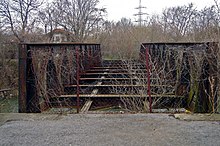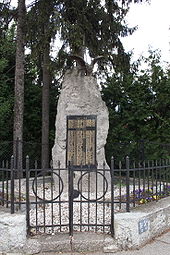Hirtenberg
|
market community Hirtenberg
|
||
|---|---|---|
| coat of arms | Austria map | |
|
|
||
| Basic data | ||
| Country: | Austria | |
| State : | Lower Austria | |
| Political District : | to bathe | |
| License plate : | BN | |
| Surface: | 1.49 km² | |
| Coordinates : | 47 ° 56 ' N , 16 ° 11' E | |
| Height : | 280 m above sea level A. | |
| Residents : | 2,611 (January 1, 2020) | |
| Population density : | 1752 inhabitants per km² | |
| Postal code : | 2552 | |
| Area code : | 02256 | |
| Community code : | 3 06 15 | |
| NUTS region | AT122 | |
| Address of the municipal administration: |
Bahngasse 1 2552 Hirtenberg |
|
| Website: | ||
| politics | ||
| Mayor : | Karl Brandtner ( SPÖ ) | |
|
Municipal Council : ( 2020 ) (21 members) |
||
| Location of Hirtenberg in the Baden district | ||
| Source: Municipal data from Statistics Austria | ||
Hirtenberg is a market town with 2611 inhabitants (as of January 1, 2020) in the Baden district , Lower Austria . The Triesting flows south of the village .
geography
The place is at the end of the Triesting Valley . The Triesting, which comes from the Vienna Woods , flows here into the Vienna Basin . Neighboring communities are Leobersdorf , Enzesfeld-Lindabrunn and Berndorf (St. Veit).
Population development
| census | Residents |
|---|---|
| 2011 | 2605 |
| 2001 | 2270 |
| 1991 | 2088 |
| 1981 | 2147 |
| 1971 | 2164 |
Source: Population development of Hirtenberg. (PDF) Statistics Austria
history
The name goes back to the Huotto fortress from the 13th century, which used to rise on a hill called Steinkamperl above the village. But there are already settlement finds from the Neolithic Age .
Since in 1477 the Hungarian King Matthias Corvinus in Austria had occurred and throughout the country places, fields and fortresses had devastated the settlement recorded a certain decline. During the first Turkish siege of Vienna , the last troops of the Ottoman commander Kasim Beys were wiped out in the Leobersdorf-Enzesfeld-Hirtenberg area on September 19, 1532 .
On January 2, 1870 (completed on December 22, 1870), the highest resolution passed to separate the village of Hirtenberg from the local or cadastral communities of Leobersdorf and Enzesfeld, and to establish Hirtenberg as an independent local community - with an area of only 1.10 km² .
At the beginning of the 20th century, the town, which was once shaped by agriculture and viticulture, developed into a commercial location, especially for the armaments industry with the famous Hirtenberger cartridge factory (see also: Wöllersdorfer Werke and Fritz Mandl ). During the market survey and the award of the coat of arms in 1929, a factory with three smoking chimneys and a water tower was chosen as the motif for the coat of arms. On January 8, 1933, the Arbeiter-Zeitung revealed the Hirtenberg arms affair . Mussolini delivered weapons to the Austrian Home Guard and to Hungary. The cartridge factory served as an interim storage facility.
The order situation of the ammunition factory in the period before the Second World War was “good” : 3800 employees produced one million cartridges per day. This performance has not been achieved by any similar factory in Central Europe.
For forced labor in the Second World War for the cartridge factory (then part of the Wilhelm Gustloff Foundation ), there was a satellite camp of the Mauthausen concentration camp from September 28, 1944 to April 15, 1945 in the eastern part of the village on the border with Leobersdorf , in which a maximum of 459 women Had to manufacture infantry ammunition.

The place has a rich club life and the house of culture, which was only renovated in 1999, with space for events for up to 600 people.
coat of arms
Blazon : In the blue shield, a silver-colored, four-aisled factory building rises on a green lawn, surmounted by a water tower and three smoking chimneys . Red firelight shines from the door and window openings.
traffic
Locally over the moves Southwest Railway from Leobersdorf coming (and since 2004 between Weissbach-Neuhaus and Hainfeld replaced by a bus line) through the Triestingtal and Gölsental to Sankt Pölten .
The Hirtenberg stop, located in Enzesfeld's municipality between a wooded slope and the banks of the Triesting, was narrowly used, depending on its location, only for passenger traffic. Local goods came (and come) via the Enzesfeld train station on the rails. For the industrial companies located in Hirtenberg, towing tracks were laid in the direction or to the Enzesfeld-Lindabrunn train station (1916: Fridolin Keller; 1917: cartridge factory; no year: to the Josef Keim und Söhne textile factory and KROMAG), but all of them were removed again.
Hainfelder Straße B18 runs parallel to the railway . A bus line runs both in the direction of Berndorf and via Enzesfeld to Leobersdorf .
Public facilities
- The Hirtenberg Prison , which has existed since 1962, is the fifth largest prison facility in Austria. The kuk officiers' orphanage institute , which migrated from Fischau , Lower Austria, was housed here until 1918 (see also: Hirtenberg Sanatorium ).
- Laura Gatner House for unaccompanied minor refugees
Attractions

- Parish Church of Hirtenberg
- Soldier
memorial next to the church: An eight-ton rock block made of Merkenstein, crowned by a wing-wielding bronze eagle, with a marble plaque with the names of the fallen and missing from the First (28 victims) and Second World War (118 victims). The unveiling took place on October 30, 1932.
Sons and daughters
- Hans Adam (1925-2013), zoologist
- Béla Barényi (1907–1997), car designer, father of passive safety
- Maria Keller-Siller (1893–1990), track and field athlete
- Carlo Romatko (1907–1992), opera singer (tenor) and actor ( The Last Chance )
- Hannes Seifert (* 1971), video game producer
literature
- Andreas Huber: The "desolate castle" of Hirtenberg. Verlag des Gymnasialverein Berndorg, Berndorf 1934, OBV .
- Walter Rieck: Cultural geography of the Triestingtal. Dissertation. University of Vienna, Vienna 1957, OBV .
- Fritz Hanauska: Heimatbuch der Marktgemeinde Hirtenberg. Market town of Hirtenberg, Hirtenberg 1980, OBV .
- Thomas Schweinschwaller: Imprisonment in a normal penal system. Analysis of the drug-free department of the Hirtenberg correctional facility. Thesis. University of Vienna, Vienna 1997, OBV .
- Klaus-Dieter Mulley (Ed.): Storeys - Scandals - Barbed wire. Workers and armaments industry in Wöllersdorf, Enzesfeld and Hirtenberg. Self-published by the union of railway workers, local group Ebenfurth Pottendorfer Linie, Ebenfurth 1999, ISBN 3-9500563-1-6 , OBV .
- Michaela Holeczy: New ways of influencing behavior using the example of the drug-free zone at the Hirtenberg Prison. Thesis. University of Salzburg, Salzburg 2001, OBV .
Web links
- 30615 - Hirtenberg. Community data, Statistics Austria .
- Hirtenberg's website
Individual evidence
- ↑ Nö LGBl 1871/3. In: State Law and Ordinance Gazette for the Archduchy of Austria under the Enns , year 1871, p. 3. (Online at ANNO ). .
- ^ Fritz Hanauska: Home book of the market town Hirtenberg. P. 214.
- ↑ Mauthausen Memorial, Federal Ministry of the Interior: The satellite camps of the Mauthausen concentration camp ( Memento of October 9, 2014 in the Internet Archive ). In: mauthausen-memorial.at , accessed on January 4, 2014.
- ^ Correspondences. (...) Hirtenberg. (Siding). In: Badener Zeitung , No. 31/1897 (17th year), April 17, 1897, p. 8, top right. (Online at ANNO ). .
- ^ Fritz Hanauska: Home book of the market town Hirtenberg. P. 244.
- ↑ The story of Hirtenberg up to 1945. In: hirtenberg.at. Archived from the original on March 17, 2011 ; accessed on December 8, 2019 .
- ^ Fritz Hanauska: Home book of the market town Hirtenberg. P. 367.
- ^ Fritz Hanauska: Home book of the market town Hirtenberg. P. 371.







